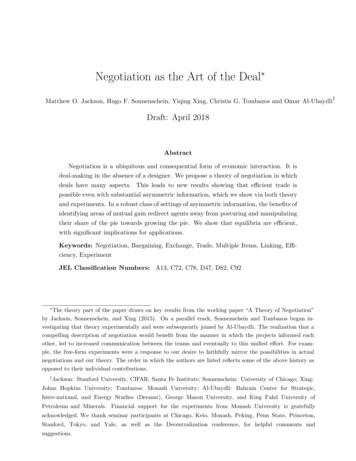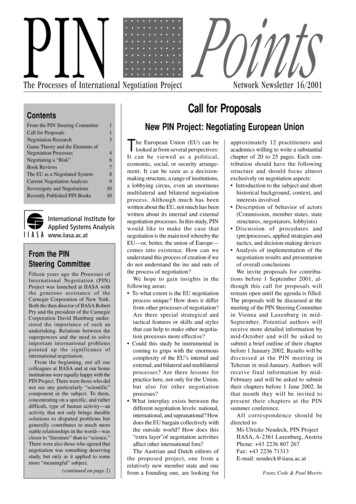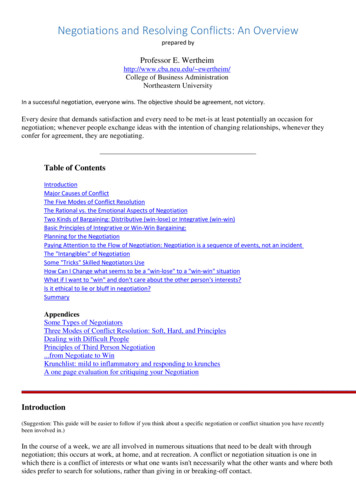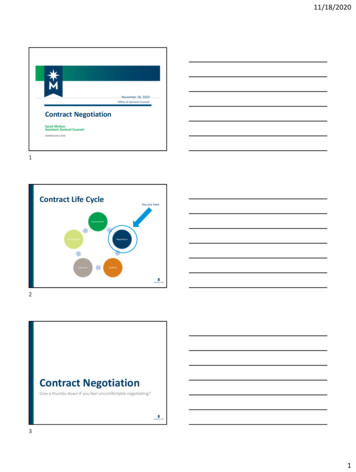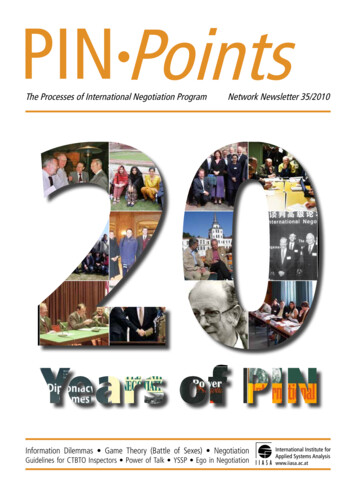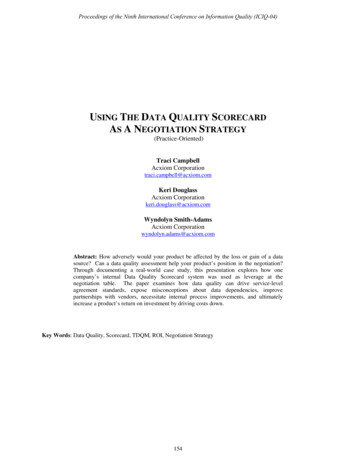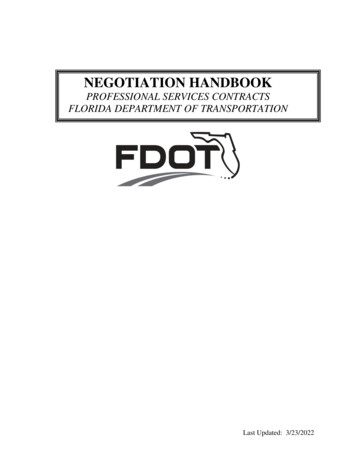
Transcription
NEGOTIATION HANDBOOKPROFESSIONAL SERVICES CONTRACTSFLORIDA DEPARTMENT OF TRANSPORTATIONLast Updated: 3/23/2022
Update History:Date of Update9/7/20079/ 24/129/18/12Section ChangedAttachment D – Current AveragesAttachment B – Field Crew Supervisor job class addedAttachment D – Current Averages & Department LimitsUpdate Operating Margin Guidelines, Section 5.0Removed Salary Escalation SectionUpdated Identification of the basis for proposed rates on page 4;Updated Direct Expense information, pages 5-6; Updated Sub costsinformation on page 6; Updated Operating Margin Section, pages 711; Updated Standard Classes in Attachment B; Updated averagesfor Overhead, Exp, & FCCM in Attachment D; Updated SelfCertification Form in Attachment E; Updated Attachment F; AddedCertification of Use of Lower Tier Subs in Attachment J.Expanded guidance related to compensation, Section 4a(2).Page NumbersD–1B – 2 thru 3D – 1 thru 29-1341- 14;AttachmentsB, D, E, F, J510/31/201411/25/2014Updated averages for Overhead, Exp, & FCCM in Attachment DAttachment DContract Modifications- Rate Adjustments to Professional ServicesPage 15Consultant ContractsAdded Policy Statement on Use of Field Office Rates for OnAttachment KPremises Consultant EmployeesUpdate Attachment D – Current Avgs & Dept. LimitsD1 – D2Update Attachment B – Add Two New CEI Job ClassesAttachment BNegotiation of cost of services section,AttachmentNegotiation of Method of Compensation, Documentation ofD,Negotiations, Termination of NegotiationsAttachment E,Update Attachment D – Current Avgs & Dept. Limits,AttachmentUpdate Attachment E – Self-Certification of Accounting System andG,Reimbursement RatesAttachment HReplace Attachment G – Reimbursement of PermitsUpdate Attachment H – Policy for Use of Department Space andEquipmentUpdate dollar threshold for requiring overhead auditAdded Contract Duration Adjustment Factor13Added Negotiation of Rates for Construction Engineering Inspection61/7/2015Update Attachment D – Current Avgs & Dept. Limits2/10/2015Update Attachment B – FDOT Standard Job ClassesAdd Attachment L - Standard Items and Item Descriptions forGeotechnical and Materials Testing firmsUpdate Attachment B – Add New Job ClassAttachment BAttachment LUpdate Senior Project Engineer and CEI Senior Project Engineer’sdefinitionsCEI Senior Project Engineer’s definitionsAttachment 157/17/2015D1 – D2Attachment BAttachment B
7/22/2015Update Sole Proprietor Costs9/16/2015Update Sub-Consultant/Subcontractor/sub-vendor costsAdd new Attachment, Attachment M – Simplified Self-Certificationfor Non-Professional Services FirmsEdit cleanup8Attachment MUpdate Attachment B – FDOT Standard Job ClassesUpdate Attachment D – Current Avgs & Dept. LimitsUpdate Operating Margin Guidelines; Attachment NAttachment BAttachment DSection 4 and5; AttachmentNAttachment 2/18/20206/28/20219/1/20213/23/2022Minor updates to qualifications for several engineering jobclassificationsUpdate Job ClassificationsUpdate Attachment D – Current Avgs & Dept. LimitsUpdate Job ClassificationsMethods of Compensation updatesClassifying consultant staff updatesUpdate Attachment CUpdate Attachment GUpdated Attachment B – Job ClassificationsUpdated Attachment D – Current Avgs & Dept. LimitsUpdated Attachment B – Job ClassificationsUpdated Attachment L - Standard Items and Item Descriptions forGeotechnical and Materials Testing firmsUpdated Attachment D – Current Avgs & Dept. LimitsUpdated Attachment J - Certification of Use of Subs and all LowerTier SubsClarified what is included in Utility costs when reimbursed as directproject cost for field officeUpdated Attachment L – Standard Items and Item Descriptions forGeotechnical and Materials Testing FirmsUpdated Attachment D – Current Avgs & Dept. LimitsUpdated Home and Field Office LanguageUpdated Attachment L – Standard Items and Item Descriptions forGeotechnical and Materials Testing FirmsClarified what is included in Utility costs when reimbursed as directproject cost for field officeUpdated Attachment L – Standard Items and Item Descriptions forGeotechnical and Materials Testing FirmsUpdated PE job classificationsUpdated Attachment D – Current Avgs & Dept. LimitsAdded Approved Rates to Attachment LUpdated Attachment B – CEI Job Classifications updated inaccordance with CEI Scope of Services.Crew rates created for Surveying and Mapping8Pages 1-9Attachment BAttachment DAttachment BAttachment CAttachment GAttachment BAttachment DAttachment BAttachment LAttachment DAttachment JAttachment LAttachment DAttachment LAttachment LAttachment BAttachment DAttachment LAttachment B
NEGOTIATION HANDBOOKPROFESSIONAL SERVICES CONTRACTSFLORIDA DEPARTMENT OF TRANSPORTATIONContents1.Fee Proposals . 22.Negotiation of Scope of Services . 23.Negotiation of Work Effort . 34.Negotiation of Cost of Services . 4a.Wage rates . 4b.Overhead . 8c.Direct expenses . 9d.Sub-consultant/subcontractor/sub-vendor costs . 105.Negotiation of Operating Margin plus Contract Duration Adjustment Factor . 116.Negotiation of Method of Compensation . 167.Documentation of Negotiations . 178.Termination of Negotiations . 179.Contract Modifications . 18Attachments . 20A.B.C.D.E.F.G.H.I.J.K.L.M.N.Automated Fee Proposal GuidelinesFDOT Standard Job ClassesAverage Actual Salary Rates and Average Negotiated RatesCurrent Averages for Audited Overhead, Expense, and FCCM RatesSelf Certification of Accounting System and Reimbursement RatesGuidelines for Field OfficesReimbursement of PermitsUse of Department Space and Equipment by ConsultantsAdministrative Add Ons for Subconsultant CostsCertification of Use of Subs and all Lower Tier SubsUse of Field Office Rates for On-Premises Consultant EmployeesStandard Items and Item Descriptions for Geotechnical and Materials Testing firmsSimplified Self Certification for Non-Professional Services FirmsGuideline for PE Acceleration Opportunities
NEGOTIATION GUIDELINESPROFESSIONAL SERVICES CONTRACTSFLORIDA DEPARTMENT OF TRANSPORTATIONIntroductionFlorida law requires state agencies to acquire Professional Services by competitive negotiation. Theprocess mandated by statute (287.055, 337.107 and 337.1075, Florida Statutes), Administrative Rule(14-75, Florida Administrative Code), and departmental procedures (FDOT 375-030-002) requires acompetitive selection of the consultants based on qualifications, followed by a competitive negotiationprocess to establish a fee for the desired services. The objective of the total consultant acquisitionprocess is the selection of a well-qualified firm at a fee that is fair, competitive and reasonable to boththe state agency and the consultant. Negotiations should be conducted in good faith, recognizing thatcompromise may be required to achieve an equitable contract. The Department’s negotiators mustrecognize the legitimate interest of the consultant industry in recovering their costs and making areasonable profit when performing work for the Department. Conversely, the consultants mustrecognize the legitimate interest of the Department in receiving quality work at a fair, competitive andreasonable cost, to accomplish the work program while maximizing the use of taxpayers’ dollars. Acontract that is beneficial to both parties is the desired outcome of a successful negotiation.The negotiation portion of the consultant acquisition process consists of establishing agreement betweenthe Department and the Consultant on the following major points:1.Scope of services to be performed2.Work effort required (both quantity and level of personnel required)3.Cost of servicesa.Wage ratesb.Overhead costc.FCCMd.Direct expenses and subconsultant costse.Operating margin and contract duration adjustment factor (CDAF)4.Method of compensationThe following information provides general guidelines for the negotiation process. Although thevarious components are described separately, the negotiation process should be approached from aholistic perspective since scope, work effort and cost are interrelated. The negotiation of one of thesevariables might have a significant impact on the other two. Both project management personnel andprofessional services staff should be involved in negotiating the contract terms for the Department.Typically, the project management personnel would assume the lead role in negotiating the scope ofservices and staff hour requirements, while professional services would assume the lead with costs andmethod of compensation. However, it is strongly recommended that one person have primaryresponsibility for the negotiation and participate in all phases of the process.1
Negotiation Procedures1.Fee ProposalsAt the completion of final selection, the number one ranked firm should be requested to providecomments on the scope of services, as well as a detailed staff hour estimate where appropriate, a feeproposal in standard format, and support for all costs contained in the fee proposal. Attachment Aprovides the Department’s Automated Fee Proposal Guidelines.Florida Statutes specifically require the Department to conduct a detailed analysis of costs forcontracts acquired under the Consultants Competitive Negotiation Act, and the fee proposal mustprovide sufficient information to allow this. The fee proposal should be reviewed as well assupporting information. Any errors, deficiencies, omissions, etc., noted during the review of the feeproposal by the Professional Services Unit (PSU) will be brought to the attention of the selectedConsultant, and corrected data will be requested immediately.2.Negotiation of Scope of ServicesThe final negotiated scope of services should be tailored to ensure a mutual understanding of theproject. During this negotiation process each work activity or milestone should be discussed todetermine how it is to be accomplished, the nature of the deliverable, and its format. If theconsultant's understanding is not in accord with that of the Department, discussions should beconducted to arrive at a mutual understanding of the services to be accomplished, the method bywhich it will be accomplished, and the nature of the final product. Either party to the negotiationsshould feel free to request written confirmation in the form of modification of the scope to reflectagreed-to terms.The scope of services is one of the major factors affecting the fee for consultant services since itdefines the nature and volume of work to be performed. A well written scope of services establishesthe tasks to be performed, materials to be delivered, meetings to be attended, schedule to be met,equipment that will be used, standards that will be followed, and responsibilities of both theconsultant and the Department.The detail established in the scope of services sets the stage for subsequent negotiations. A detailedand thorough scope of services leads to an understanding of the services needed to complete theassigned project as well as an understanding of the sequence of tasks to be accomplished. Thisallows for informed development of the staff-hour estimates and project fee.The scope of services should be prepared in standard Department format. A standard scope ofservices is available on the Department’s website for project development & environmental studies(PD&E), highway and bridge/structural design, construction engineering & inspection (CEI), anddistrict geotechnical and materials testing projects. The standard scope of services should be used,where practical, however, modifications should be made to reflect the actual agreed-to terms andrequirements for the specific project. This will facilitate preparation and evaluation of staff hourestimates, and any desired modification of the scope during the negotiation process.Following are typical major items within the scope of services requiring negotiation:2
a.b.c.d.e.3.Work activitiesDeliverablesNumbers of and types of meetings, presentations, etc. to be attended or providedSchedule for project servicesDivision of responsibilities and relationship between Consultant and DepartmentNegotiation of Work EffortThe objective of this process is to ensure that the proposed staff hours are reasonable for the specificproject. It is also critical to determine if a reasonable distribution of work among various levels ofstaff is proposed to ensure the most economical staffing commensurate with the complexity of theproject.Upon receipt by the Department of the Consultant's staff hour estimate, the Department's estimateshall be provided to the consultant. The Consultant's staff hour estimate should be compared withthe Department's and the differences evaluated. Discussions will be conducted with the Consultantto resolve differences between the Department and consultant staff hour estimates. As with theentire negotiations process, a record should be kept of the key points discussed and the resultingresolution.The basis for an accurate staff hour estimate is a well-developed scope of services. With such abasis, a series of work activities may be readily identified as staffing elements. Those elementsshould be used for both the Department and consultant estimates for ease of reconciliation. Theestimates by both parties should be made in the same standard format. Standard Staff HourEstimation forms are available in Excel format for PD&E, highway and bridge/structural designprojects on the Department’s Project Management/Production Support Office website. For PD&E,highway and bridge/structural design, the Department’s Staff Hour Estimating spreadsheet formsmust be used by both the Department’s project manager and the selected consultant in preparing thestaff hour estimate to facilitate the negotiation process.The published typical ranges of staff hour effort should be treated as only a beginning point. Eachproject must be independently evaluated to determine a fair estimate of required staff hours. Thebasis for the estimate should be the specific requirements for the project under consideration togetherwith a history of actual staff requirements for past projects with similar requirements. Wherespecific requirements cannot be identified during the negotiation phase, a limiting amount will bemade to serve as the basis of the contract.Following are the major items relating to work effort requiring negotiation:a.b.c.d.e.4.Staff hours, overtime, survey crew days, etc.Levels of personnel requiredDistribution of work among levels of personnelSubconsultants (Quantity of work effort, personnel)Delineation of work to be provided by consultant, the Department, or othersNegotiation of Cost of Services3
a.Wage rates:In accordance with Florida Statute, the PSU must perform a cost analysis to ensure theproposed costs are reasonable, accurate and allowable.The fee proposal must contain a certification that any direct costs proposed are not includedas overhead in the Consultant's accounting system (Form No. 375-030-39). The certificationshould be signed by the Consultant's comptroller, chief financial officer, accountant, or otherappropriate person who is knowledgeable of the Consultant's normal accountingrequirements. At a minimum, the review of the fee proposal by the PSU must include thefollowing:(1)Identification of the basis for rates(a)The wage rates must be certified in writing as being current and accurate by aresponsible company official. The Department will require payroll registersto confirm the accuracy of the pay rates. The submittal will contain acertification from a responsible company official that the rates are actualcurrent rates on that particular date. A payroll register is defined as a recordof pay details for an employee during a specified pay period. The payrollregister will display the following information about the employee: name ofemployee, date, date range, hours (regular and overtime), gross pay,deductions, taxes withheld, and net pay. A payroll register is not a monthlyprojection, payroll forecast, or certified pay rate. Confidential informationmay be redacted. When negotiating a new contract, Procurement usesresumes to validate and confirm employee job classification in accordancewith the Typical Definitions in Attachment B, with the exception of anyCTQP needs. CTQP shall be verified by the FDOT Project Manager.(b)If averages for select employees are used, payroll information of how theaverage rate was computed (i.e., straight average, weighted average, etc.)must be provided. When this is the case, care should be taken that onlyemployees actually committed to and needed for the project are used incomputing the average.(c)Consultants (geotechnical, aerial photography, etc.) that normally work on aunit price basis will be required to provide a copy of their standard feeschedule and attest that the fees contained therein are their normal fees forsuch services (whether performed for private or governmental clients). Inaddition, identification of the cost basis for such rates (i.e. labor hours andwage rates, overhead and operating margin, equipment use rates verified byaudit, etc.) should be required where practical. Firms who are compensatedin whole or in part using fee schedule rates will be required to complete acertification statement during contract negotiations, attesting to fulldisclosure of intended use of lower tier subconsultants/subcontractors/subvendors, including use of drilling subs. All lower tiered subconsultants/subcontractors/subvendors must be named in the agreement in accordance with4
Section 4 of the Standard Professional Services Agreement in order to r/subvendor.Geotechnical and Material Testing firms shall utilize the Standard Items andItem Descriptions for Geotechnical and Materials Testing firms identified inAttachment L when submitting the AFP.(d)(2)The Department has standardized the material and geotechnical testing rates(pay items). The listing of the Standard Items and Item Descriptions forgeotechnical and materials testing pay items is available in Attachment L ofthe Negotiation Handbook, as previously referenced. Please utilize thestandard numbering convention when proposing geotechnical and materialstesting pay items. In an effort to promote uniformity and consistency duringnegotiation of these rates, it shall be the Department’s policy to compensatefirms for geotechnical and materials testing pay items based on the firm’ssubmitted pay item rate, up to the mean/average proposed rate for that payitem, in accordance with the Department’s Table 6 Loaded Rates jobclass(based on one year of data obtained from the Table 6 Loaded Rates Reportfor the District). If there are insufficient data to provide a District average fora given pay item, the District may utilize the proposed statewidemean/average as the maximum, for material and geotechnical testing payitems.Steps for classifying consultant staff in accordance with standard job classesConsultants shall adhere to use of the standard job classes in the NegotiationHandbook when classifying consultant staff, in order to ensure consistency anduniformity in the establishment of contract rates. During contract negotiations, theconsultant shall propose staff within standard job classes as referenced in the AFPand Attachment B, and shall submit resumes. The resumes are used by FDOTProcurement staff to validate and confirm the proposed job classifications.Procurement reviews the proposed staff within a classification, checking resumeinformation against the definition in Attachment B. Consultant staff who do not fitthe definition for the job class will need to be reclassified. For purposes ofestablishing contract job classes, consultant staff are classified according to theclassification definition provided in the Negotiation Handbook, and are not classifiedbased on the position or title they may hold within their firm. Standard Job Classesin the Negotiation Handbook are used for aggregating similar staff based on years ofexperience, education, and licensure/certification.Procurement will use the Negotiation Handbook to correlate proposed consultantstaff to the appropriate classification. The consultant staff-person shall be classifiedbased on the highest level job class that matches his/her total years of experience,education, and licensure/certification, in accordance with the FDOT Standard JobClass definitions. Consultation with Central Office Procurement may be necessary5
for classification of consultant staff in positions with limited definitions within theNegotiation Handbook.Once proposed consultant staff are properly classified, Procurement will accept theposition contract rate based on actual current salary rates of staff within the position(as supported by payroll registers). The staffing pool and percentage use of staff(weighting) within the same job class can be negotiated based on scope and projectneeds. Only staff actually committed to and needed for the project are to be used incomputing the contract rate. The 75th percentile shall be used as the benchmark forCEI job classes on CEI contracts, in accordance with Section (4) of NegotiationProcedures, FDOT Negotiation Handbook. The 75th percentile for a CEI job classon a CEI contract may be exceeded due to CEI project complexity. Procurementdoes not determine CEI project complexity; this is established by the ConstructionOffice, District Construction Engineer.Classifications are established for the prime firm, and for each of the sub firms.Prime and sub staff are not combined; separate job classes are established for eachseparate consultant firm. If a firm does not have staff to fill all necessary positionsrequired for their activity, Procurement will inform the prime consultant. TheDepartment will either move forward with the classifications as they are, or as apoint of negotiation, the Department may consider the consultant’s proposal of stafffrom other higher classifications that can also perform that function. Since thesestaff will not generally fit within the classification, they may be at a wage rate higherthan the range of rates paid for that classification (as supported by the wage ratedata). In such instances, for purposes of negotiating the contract rate used toestablish the consultant fee or to establish contract rates, FDOT will propose themean/average for that classification (based on one year of data obtained from theConsultant Wage Rate Report for the District). Note; this is not a cap of theconsultant’s rates. This scenario sometimes occurs with subs, for example, where aPrincipal of a firm is being proposed for multiple classifications including lowerclassifications. The individual shall be classified based on the highest jobclassification in accordance with their resume and the classification definition theirexperience, education, etc., would correlate to within the Standard Job Classes in theNegotiation Handbook. If the individual is also being proposed in multiple lower jobclasses, the Department will need to make a determination whether the individual isneeded to fill those lower job classes. If the FDOT Project Manager agrees that theyare, the Department will offer the mean/average for that classification or theindividual’s actual salary, whichever is lower, to be used for purposes of establishingthe contract rate for a job classification where the individual exceeds the qualificationrequirements.(3)Negotiation of salary rates or compensationConsultants with audited overhead rates who maintain a published fee schedule butdo not bill exclusively from the schedule must maintain a job cost accounting systemfor their hourly services. However, the direct costs of services billed on cost-basedrates or scheduled fees, shall be excluded from the calculation of direct expense6
rates. The accounting system description will include assurance of the segregation ofthe costs to deliver fee or rate based services from the costs associated with hourlyservices. The Basis of Accounting and Description of Accounting System Noteshould contain the following text, or text containing the same essential elements:“The Company maintains a job-order cost accounting system for the recording andaccumulation of costs incurred under its contracts. Direct costs incurred in providingservices billed to clients at unit rates or on the basis of a published fee schedule arecharged by functional accounts and accumulated as a single project or grouping toallow segregation of such costs from other direct costs. Each project is assigned a jobnumber so that costs may be segregated and accumulated in the Company’s job-ordercost accounting system.”A comparison of the actual current salary rates with prevailing rates for the class ofpersonnel will be performed. The Consultant Wage Rate Report on the Procurementwebsite provides wage rate statistics for various Consultant staff classifications bydistrict. The Consultant Wage Rate Report can be accessed at the following htm#jobclassThe Consultant Wage Rate Report shall be run and printed on the submittal due datefor the Automated Fee Proposal or the actual date the Automated Fee Proposal isreceived by the department, whichever occurs first. If personnel with unusually highsalaries are proposed, the negotiators must determine whether there is sufficient needfor that individual to justify their work on the project at that rate. If there is not alegitimate need for their expertise, they will not be allowed to bill time on theproject. The Department may negotiate contract rates as averages for employeeclassifications.Arbitrary or across the board limitations on direct salary/wage rates which do notconsider the factors prescribed in the Federal Acquisition Regulation (FAR) costprinciples are contrary to the requirements of the Federal Brooks Act, 40 U.S.C.1104(a)), which requires fair and reasonable compensation considering the scope,complexity, professional nature, and value of the services to be rendered (as requiredin 23 U.S.C. 112(b)(2). Additionally, if limitations or benchmarks on direct salaryrates and total compensation are too low, it could limit the number of firms and thequalifications of the firms which submit proposals to perform work on projects.Furthermore, direct labor limitations or benchmarks not supported by the costprinciples create associated disallowed indirect costs which effectively limits thecalculated indirect cost rate, contrary to 23 U.S.C. 112(b)(2)(D) and 23 CFR172.7(b).(4)Negotiation of Rates for Construction Engineering InspectionWhen negotiating professional services contracts for Construction EngineeringInspection (CEI), FDOT has established a benchmark, based on the Consultant WageRate Report (link provided in Attachment C). This database of wage rateinformation is provided by employee classification, and by geographic location7
(district).For purposes of negotiating CEI consultant personnel direct salaries by jobclassification, FDOT will analyze the experience and quality of the individualproposed for rate determination and use the appropriate district 75th percentile by jobclassification (i.e., upper quartile) as the maximum limit, based on one year historyof actual unloaded rates. Where there are multiple staff proposed in a singleclassification, the 75th percentile should be applied to the weighted average or thestraight average, as applicable. However, the 75th percentile may be exceeded whenwarranted by project complexity. When the 75th percentile is exceeded, it will onlybe for the select position(s) that warrant such an increase, as determined by theassigned Construction Office. A complex CEI project is defined as one that hasnumerous complicated traffic phases, involves highly technical construction featuresrequiring specialized skills of the inspection staff. A complex project may alsoinclude complex involvement by multiple third parties (i.e., multiple utilityrelocations, railroads, airports, regulatory agencies, municipalities). The size of theproject will not necessarily determine whether the construction project is complex.Large, repetitive projects on their own are not considered complex. The projectcomplexity and essential staff requirements shall be addressed by the Department’srepresentative and/or the Technical Review Committee at the Consultant marketingmeetings, the pre-proposal meeting, and the pro
(PD&E), highway and bridge/structural design, construction engineering & inspection (CEI), and district geotechnical and materials testing projects. The standard scope of services should be used, where practical, however, modifications should be made to reflect the actual a


